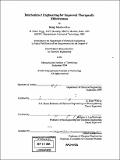| dc.contributor.advisor | K. Dane Wittrup and Douglas A. Lauffenburger. | en_US |
| dc.contributor.author | Rao, Balaji Madhav, 1978- | en_US |
| dc.contributor.other | Massachusetts Institute of Technology. Dept. of Chemical Engineering. | en_US |
| dc.date.accessioned | 2005-09-27T17:35:51Z | |
| dc.date.available | 2005-09-27T17:35:51Z | |
| dc.date.copyright | 2004 | en_US |
| dc.date.issued | 2004 | en_US |
| dc.identifier.uri | http://hdl.handle.net/1721.1/28664 | |
| dc.description | Thesis (Ph. D.)--Massachusetts Institute of Technology, Dept. of Chemical Engineering, 2004. | en_US |
| dc.description | Vita. | en_US |
| dc.description | Includes bibliographical references (p. 97-103). | en_US |
| dc.description.abstract | (cont.) (K[d] [approximately] 10pM) for its private alpha receptor subunit, unlike wild-type IL-2 (K[d] [approximately] 10 nM). IL-2 mutants with picomolar affinity for IL-2Rα stimulate T cell growth responses quantitatively equivalent to those mediated by IL-15. Our results suggest that the contrasting effects of IL-2 and IL-15 on T cells in vivo are largely due to the 1,000-fold different affinities of wild-type IL-2 and IL-15 for their respective private alpha receptor subunits. | en_US |
| dc.description.abstract | Interleukin-2 (IL-2) is an immunomodulatory cytokine that is clinically relevant for the treatment of metastatic renal cell carcinoma and melanoma. The primary objective of the research presented in this thesis was to generate IL-2 mutants with potentially improved therapeutic effectiveness. Based on qualitative considerations and simple mathematical modeling, we hypothesized that IL-2 mutants with increased affinity for the alpha subunit of the IL-2 receptor (IL-2Rα) would have increased potency for proliferation of activated T cells and hence potentially improved therapeutic value. Yeast surface display and directed evolution were used to generate a class of IL-2 mutants with enhanced IL-2Rα affinity. In a novel pulsed bioassay designed to approximate the rapid systemic clearance pharmacokinetics of IL-2, these mutants exhibit significantly increased potency for T cell proliferation, thus validating our hypothesis. Our results underscore the critical nature of the choice of appropriate bioassays to evaluate engineered proteins and other drugs. Conventional bioassays not only fail to reveal the increased potency resulting from enhanced IL-2Rα affinity (false negatives), but also suggest improved potency for a mutant without enhanced activity in the pulsed bioassay (false positive). Cell-surface IL-2Rα acts as a ligand reservoir for the IL-2 mutants, leading to increased cell-surface persistence of the IL-2 mutants with increased IL-2Rα affinity and consequently increased integrated growth signal. This is analogous to the prolonged persistence of IL-15 on cell surface IL-15Rα reservoirs. IL-2 and IL-15 signal through the IL-2Rβ and IL-2R[gamma] subunits while each have a private non-signaling alpha receptor subunit. IL-15 has a high affinity | en_US |
| dc.description.statementofresponsibility | by Balaji Madhav Rao. | en_US |
| dc.format.extent | 106 leaves | en_US |
| dc.format.extent | 4783503 bytes | |
| dc.format.extent | 4796102 bytes | |
| dc.format.mimetype | application/pdf | |
| dc.format.mimetype | application/pdf | |
| dc.language.iso | en_US | |
| dc.publisher | Massachusetts Institute of Technology | en_US |
| dc.rights | M.I.T. theses are protected by copyright. They may be viewed from this source for any purpose, but reproduction or distribution in any format is prohibited without written permission. See provided URL for inquiries about permission. | en_US |
| dc.rights.uri | http://dspace.mit.edu/handle/1721.1/7582 | |
| dc.subject | Chemical Engineering. | en_US |
| dc.title | Interleukin-2 Engineering for improved therapeutic effectiveness | en_US |
| dc.type | Thesis | en_US |
| dc.description.degree | Ph.D. | en_US |
| dc.contributor.department | Massachusetts Institute of Technology. Department of Chemical Engineering | |
| dc.identifier.oclc | 58974111 | en_US |
